

Ama Divers: Free-diving in the Shima Peninsula
|
The unique coastal environment of the Mie’s Shima Peninsula is an area known historically for its rich marine biodiversity. The peninsula itself is shaped like a hook, and extends out toward the Pacific Ocean from the mainland. Its rugged shorelines are made up of many inlets, formed by ancient river valleys. The coastal area is also home to many bays - the most famous of which, Ago Bay, is well-known as the country’s centre of pearl cultivation.
Having come from the surrounding mountains, the waters in the peninsula's many inlets and bays are rich in minerals. As such, the waters are able to support a wide variety of marine life. Besides pearl-cultivating oysters, the waters around Mie are known to support a wide variety of highly-prized shellfish and seafood: it is home to the region’s famed Ise lobsters, as well as abalone, scallops, turban snails, and sea urchins. Seaweed can also be harvested from the rich seaweed forests in the sea. It is needless to say then that the Ise-Shima-Toba region that surrounds the peninsula enjoys a thriving commercial fishing industry. However, many may not know of a traditional method of fishing that is preserved by a small number of practitioners in the region. Instead of sailing out to sea on boats and reeling in fish with rods and nets, special free divers plunge into the depths of the sea to harvest shellfish with little more than a handful of rudimentary tools. These free divers are known as ama (海女). As the name suggests, ama are female divers that free dive -without the help of scuba tanks- to harvest shellfish from the sea floor. This centuries-old profession is even on UNESCO’s list of Intangible Cultural Heritage. Although this traditional method of fishing is practiced in coastal areas in various parts of Japan, Mie prefecture has a lengthy history linked to ama diving; perhaps due to the abundant marine life present in the peninsula, nearly half of the ama divers active in the country worked in the seas of Mie. The tradition is well-maintained in the prefecture, as it is home to museums such as the Ama Museum and the Toba Sea-Folk Museum. There are also a handful of ama huts (or amagoya, as they are known in Japanese) in the area that are open to visiting tourists. Ama divers rest and relax at these huts, and some even double as restaurants; tourists can taste freshly-caught seafood and listen to stories told first-hand by the divers. |
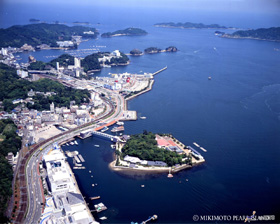 © JNTO 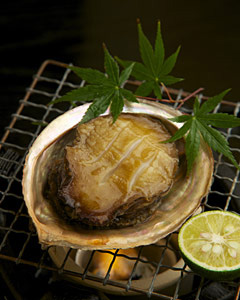 Coorperation: Nihonryori Tai 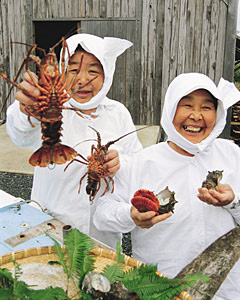 © Web Japan |
|
Traditionally, ama divers went fishing dressed only in white cotton clothing. They either walked into the sea (these divers are known as 徒人 ‘kachido’), or went out further into the ocean on boats (these divers are known as 舟人 ‘funado’). They carried few essential tools on their diving trips: awabiokoshi (アワビオコシ), steel abalone picks with wooden handles; kaginomi (カギノミ), a hooked tool that is used to pick shells and sea urchins from the sea floor, and to stabilise divers when they were climbing on slippery rocks; and the isonomi (磯ノミ), a tool that is used to dislodge abalone from rocks. They also made use of their spoils to create innovative tools that helped them on their dives. For example, the iridescent undersides of abalone shells are used as markers to indicate where abalone are; ama divers can surface temporarily to take a breath and return later to where they see the glint and shine of their markers to harvest the abalone they had previously located. While the materials of the divers’ tools and implements have changed over the years, the shape and appearance have remained largely the same.
Nowadays, many ama divers have traded their cotton wraps for wetsuits, but they still refuse to adopt the use of oxygen tanks. Without tanks and other breathing apparatuses, ama divers can usually work for a few hours in the seas before getting tired. In spite of the danger posed by free-diving, many believe that it is important to stick to the core of the free-diving tradition. Furthermore, they believe that not using oxygen tanks will limit their time under the sea, thereby reducing their likelihood of overfishing and depleting the ocean’s resources. Fishing seasons are decided by the prefectural government, and the lengths of each season can vary according to the targeted sea creature. Ama divers make sure to harvest only during these seasons and avoid picking sea creatures that are too small. This sustainable form of fishing relieves the burden on the environment, and ensures the preservation of a healthy ecosystem that the community can rely on for generations to come. Outside of fishing seasons, ama divers make a living by processing other seafood products, or work in various ryokan or shrines. Some operate ama huts where they share the history of the profession, and personal experiences with curious visitors. One of the prefecture’s major festivals that ama divers take part in is known as the Shirongo Matsuri. It is held every July in Sugashima, an island located in Ise Bay that is historically linked with ama divers. At this festival, ama divers gather to pray for their safety at sea and for abundant catches. While fishing is usually prohibited in the waters around the island, as part of the festival, ama divers race in the seas to find a pair of abalone. The first diver to find a male and female pair of abalone, known collectively as lucky abalone, is named the chief diver for the coming year. Unfortunately, the exhaustive and dangerous nature of the profession has meant that the number of young women becoming ama divers has been declining. To keep this tradition alive, the Toba municipal government has offered apprenticeships to young women who wanted to move to the rural community and learn how to be ama divers. This has attracted some young applicants, some of whom used to be professionals that worked in urban centres such as Tokyo! Although free-diving is not an easy way to make a living, the ama divers of Mie prefecture continue to keep this traditional lifestyle alive with their strong passions. Their lives are inextricably linked with the sea - for those who want an authentic insight into the gorgeous nature and rich marine life that lives on Mie’s coastline, do make sure to sit down for a meal with ama divers when you are in Mie. |
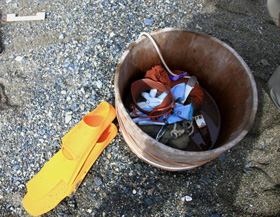 © photoAC 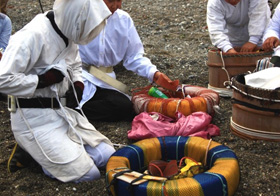 © photoAC 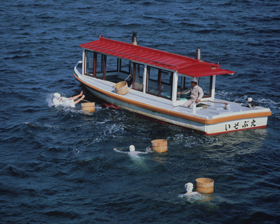 © amanaimages 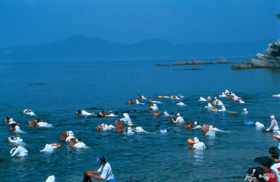 © JNTO 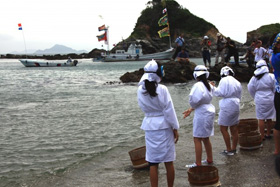 © photoAC 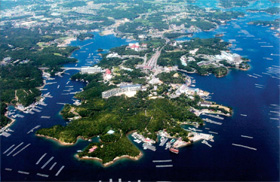 © Japan Up Close, Web Japan |
| JCC will be featuring Mie prefecture next for our “Zoom In!” series, so do keep an eye out for more interesting topics related to this central Japanese prefecture. |
Resources
|
Mie Torchbearer keeping the ama tradition alive. (2020). Retrieved 20 October 2020, from https://tokyo2020.org/en/torch/news/torchbearers-mie01 |
|
Japan Creative Centre 4 Nassim Road, Singapore 258372 +65 6737 0434 / jcc@sn.mofa.go.jp https://www.sg.emb-japan.go.jp/JCC/ Nearest parking at Orchard Hotel & Delphi Orchard |
 |